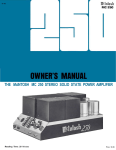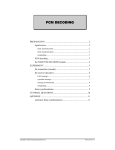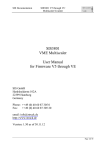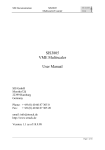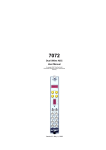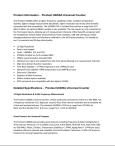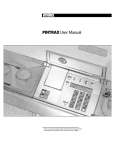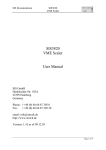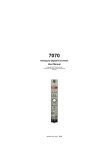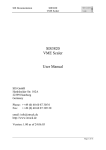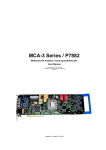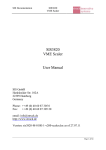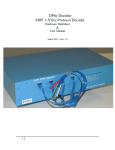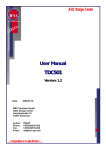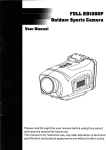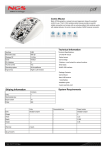Download TD2000 - FAST ComTec
Transcript
TD2000 Ultrafast Timing Discriminator User Manual copyright FAST ComTec GmbH Grünwalder Weg 28a, D-82041 Oberhaching Germany Version 1.5, August 5, 2013 Warranty Warranty Equipment manufactured by FAST ComTec GmbH is warranteed against defects in materials and workmanship for a period of twelve months from date of shipment, provided that the equipment has been used in a proper manner as detailed in the instructions manuals. During the warranty period, repairs or replacement will be made to FAST ComTec's discretion on a return to factory basis. The transportation costs, including insurance to FAST ComTec is the responsibility of the customer except for defects discovered within 30 days after receipt of the equipment, where shiping expense will be paid by FAST ComTec. Copyright 1988 - 2009 FAST ComTec GmbH, D-82041 Oberhaching, Germany All rights reserved. This manual contains proprietary information; no part of it may be reproduced by any means without prior written permission of FAST ComTec, Grünwalder Weg 28a, D-82041 Oberhaching, Germany. Tel: ++49 89 66518050, FAX: ++49 89 66518040. The information in this manual describes the hardware and the software as accurately as possible, but is subject to change without notice. ComTec GmbH II Table of Contents Table of Contents 1. Introduction..........................................................................................................................1-1 2. Hardware Description ..........................................................................................................2-1 3. Specifications ......................................................................................................................3-1 3.1. Performance characteristics ....................................................................................3-1 3.2. Absolute maximum ratings.......................................................................................3-1 3.3. Recommended operating conditions........................................................................3-1 3.4. Technical data.........................................................................................................3-1 3.4.1. Signal input .................................................................................................3-1 3.4.2. Threshold monitor .......................................................................................3-2 3.4.3. VETO input .................................................................................................3-2 3.4.4. Unshaped outputs .......................................................................................3-2 3.4.5. Shaped outputs...........................................................................................3-2 3.5. Diagrams.................................................................................................................3-4 3.6. Power requirements ................................................................................................3-9 3.7. Metal Case ..............................................................................................................3-9 3.8. Accessories.............................................................................................................3-9 ComTec GmbH III Table of Figures Table of Figures Fig. 1: Fig. 2: Fig. 3: Fig. 4: Fig. 5 Fig. 6: Fig. 7: Fig. 8: Fig. 9: Fig. 10: Fig. 11: Fig. 12: Fig. 13: Fig. 14: Fig. 15: Fig. 16: Fig. 17: Fig. 18: Fig. 19: Fig. 20: Fig. 21: Fig. 22: Fig. 23: Fig. 24: Fig. 25: Fig. 26: Fig. 27: Fig. 29: Fig. 28: Fig. 30: Fig. 31: Fig. 32: Input panel .............................................................................................................2-1 Output panel...........................................................................................................2-1 Simplified schematic...............................................................................................2-2 Theory of operation for falling-edge shaper sensitivity.............................................2-3 Unshaped output pulseform....................................................................................3-4 Unshaped output fall time .......................................................................................3-4 Unshaped output rise time......................................................................................3-4 Unshaped output rise time......................................................................................3-4 Shaped neg. out min. width ....................................................................................3-4 Positive output pulseform........................................................................................3-4 Positive output rise time..........................................................................................3-5 Positive output fall time...........................................................................................3-5 Positive output small width......................................................................................3-5 Positive output min. width .......................................................................................3-5 Positive output max. width ......................................................................................3-5 Input sensitivity.......................................................................................................3-5 Input to unshaped out delay....................................................................................3-5 Input to shaped out delay........................................................................................3-5 Fast NIM output amplitude (log. frequency scale)....................................................3-6 Fast NIM output attenuation (log. frequency scale) .................................................3-6 2.3GHz signal example...........................................................................................3-6 Double pulse behavior............................................................................................3-6 Min. double pulse time delay ..................................................................................3-6 Shaped neg. out at 400MHz ...................................................................................3-6 VETO input pulse example .....................................................................................3-6 Compare 1GHz signals...........................................................................................3-7 Jitter test input signal..............................................................................................3-8 Jitter of unshaped output ........................................................................................3-8 Jitter of shaped neg. output (falling edge) ...............................................................3-8 Jitter of shaped neg. output (rising edge) ................................................................3-8 Jitter of shaped pos. output (rising edge) ................................................................3-9 Jitter of shaped pos. output (falling edge)................................................................3-9 ComTec GmbH IV Introduction 1. Introduction The TD2000 is a fast leading-edge timing discriminator intended for signal conditioning of fast detector pulses. Applications are ultra high count rate Single Photon Counting, LIDAR, TOF Mass-Spectrometry, ultra high count rate multiscaling etc. A total of 4 outputs enables versatile connections to subsequent data acquisition devices. There is both an inverting and a non-inverting unshaped fast-NIM output delivering a 3dB bandwidth of approximately 2.4GHz. In some electronic environments these outputs may be useful for data rates of over 3GHz. The pulsewidth of the shaped outputs is screwdriver adjustable over a wide range from <1ns (typ. 750ps) to more than 300ns. “Shaped” in this context means the output pulsewidth is not dependent on the input pulsewidth but only on the screwdriver adjusted time intervall. The leading edge of the output pulse indicates the input threshold crossing and may be used for timing. These shaped outputs provide a pulse pair resolution of 2.5ns which corresponds to a continous wave operation capability of 400MHz. A fast-NIM (negative) and a positive voltage follower output (typ. +2V) are available for the shaped signals. The fast NIM compatible VETO input enables inhibiting the shaped outputs. Using this, even a single pulse can be gated out of an outgoing (e.g. 400MHz) pulse train. ComTec GmbH 1-1 Hardware Description 2. Hardware Description NOTE: To safely avoid damage to the TD2000 and the signal source as well, the TD2000 discriminator should be powered ON before connecting active input signals. Fig. 1: Input panel Fig. 2: Output panel The TD2000 ultra fast discriminator consists of 2 major component elements. First, there is the non-shaping discriminator that produces a fast 1 bit digital output depending on whether the input signal is below or above the threshold level. The non-inverting output will produce a 0V level if the input is above the threshold and –800mV (into 50 ) when the input is below the threshold. Thus, the non-inverting output “follows” the input signal. An inverting output is available as well. Second, there is a shaping, leading-edge discriminator. The simplified principle of operation is as follows: the switch selected rising or falling edge (threshold crossing) of the input signal sets a flip-flop. To obtain a specific output pulse width the output of the flip-flop is delayed and fed back into the flip-flop’s reset input, effectively forming a one-shot. The pulse width is adjustable by ComTec GmbH 2-1 Hardware Description changing the delay. Turn the small trimmer screw (ref. Fig. 2) clockwise to reduce the pulse width, anti-clockwise for wider pulses. NOTE: Only the leading edge (falling edge for the fast-NIM output and rising edge for the positive output) of the shaped outputs is intended for timing purposes. The trailing edge of the shaped output signal is not practical for timing measurements because there are situations were the pulse width is not precisely stable e.g. in the case of a second input pulse arriving with only a short delay of less than the sum of the shaped pulsewidth and approximately 1.5ns, the output pulse might be wider than expected (ref. Fig. 23). The leading edge of the output pulse nevertheless stays correct. The VETO input inhibits the start of the one-shot (ref. 2nd input pulse in Fig. 4) if the VETO input is below the fixed threshold of approximately –300mV which is compatible to fast NIM signals. In Fig. 25 you can see an example of a single pulse gated out of a 400MHz pulse train. Fig. 3: Simplified schematic For precise control of the threshold level a monitor output can be connected to a high impedance voltmeter by 2mm banana plugs or appropriate test tips. Referring to Fig. 1, the lower jack is ground (GND) while the upper jack delivers the threshold voltage. Turn the precision potentiometer anti-clockwise for a lower (more negative) threshold, clockwise for more positive levels. Generally the threshold level should be set well in the middle of the input signal amplitude. For best timing accuracy it should be set in the steepest portion of the input slopes. ComTec GmbH 2-2 Hardware Description Fig. 4: Theory of operation for falling-edge shaper sensitivity The negative going outputs are current mode / fast NIM outputs delivering -16mA into external 50 to GND. The positive output is formed by an emitter follower. NOTE: The positive output is generally slower than the fast NIM signals. It is NOT short circuit protected, so use caution when connecting this output! ComTec GmbH 2-3 Specifications 3. Specifications 3.1. Performance characteristics Fast NIM Output Bandwidth: 3dB, ref. Fig. 20 .......................................................... typ. 2.4GHz Shaped outputs data rate: continous wave operation, ref. Fig. 24 ..................... max. 400MHz Pulse pair resolution: (shaped outputs) ............................................................ typ. 2.5ns Propagation delay: input-to-unshaped-output, ref. Fig. 17 ............................. typ. 1.7ns input-to-shaped-output, ref. Fig. 18 ................................ typ. 3.3ns 3.2. Absolute maximum ratings Power supply: 100ms max. ............................................................................ 25V Signal input: .................................................................................. -3.0 to +4.0V VETO input: .................................................................................. -3.0 to +4.0V ESD rating: ....................................................................................1500V HBM Positive shaped output: sink current ............................................................... max. 120mA ............................................................. NOT short circuit protected 3.3. Recommended operating conditions Power supply: (from external power source) ............................................. +12VDC Output termination: (except threshold monitor) ...................................................... 50 Voltmeter impedance: (for threshold monitoring) .................................................. Input signal slew rate: ........................................................................................... 5V/µs Ambient temperature: .................................................................................... 0 … +50°C 3.4. Technical data1 3.4.1. Signal input 10M Connector: ................................................................................... female BNC Impedance: ............................................................................................... 50 Input voltage range: .................................................................................. -2.0 to +3.0V Input sensitivity: ref. Fig. 16 ...................................................................... <10mVPP Slew rate requirement: ........................................................................................... 5V/µs Threshold voltage: ........................................................................................... ±1.25V .............................. adjustable by a 10-turn precision potentiometer 1 All data is taken with output terminations of 50 ComTec GmbH to GND if not otherwise noted 3-1 Specifications 3.4.2. Threshold monitor Connector: ........................................................................... female 2mm jack Signals: ................................................................. threshold voltage / GND Impedance: ................................................................................................ 2k 3.4.3. VETO input Connector: ................................................................................... female BNC Impedance: ............................................................................................... 50 Input voltage range: .................................................................................. -2.0 to +3.0V Slew rate requirement: ........................................................................................... 5V/µs Threshold voltage: ......................................................................................... -300mV Setup time: VETO to SIGNAL edge .................................. -265 / -375 / -545ps2 Hold time: VETO after SIGNAL edge ............................. +465 / +575 / +745ps 3.4.4. Unshaped outputs Connectors: inverting & non-inverting ............................................. female BNC Impedance: ..................................................................... back-terminated 50 Output signal: fast NIM / current mode............................ -16mA into external 50 Fall time: 90% to 10%, ref. Fig. 6 .................................................. typ. 180ps Rise time: 10% to 90%, ref. Fig. 7 .................................................. typ. 500ps 20% to 80%, ref. Fig. 8 ...................................................typ. 220ps Jitter3: RSM = standard deviation, ref. Fig. 27 .................. approx. 2psRMS ...............................................................< 20psPk-Pk (typ. 17psPk-Pk) 3.4.5. Shaped outputs Pulsewidth: ref. Fig. 9 ................................................... min. <1ns (typ. 750ps) ref. Fig. 15 ................................................................ max. 300ns ....................................................... 10-turn screwdriver adjustable Fast NIM / negative shaped output Connector: ................................................................................... female BNC Impedance: ..................................................................... back-terminated 50 Output signal: fast NIM / current mode............................ -16mA into external 50 Jitter (falling edge): RSM = standard deviation, ref. Fig. 29 .................. approx. 2psRMS ...............................................................< 20psPk-Pk (typ. 17psPk-Pk) Jitter (rising edge): RSM = standard deviation, ref.Fig. 30 ................... approx. 5psRMS ................................................................................ typ. <65psPk-Pk 2 Setup and hold times (min./typ./max.) are calculated from component datasheets and PCB transmission line delays. They are dependent on input overdrive, slew rate, temperature etc. 3 The jitter of the scope timing is specified to be typ. 1.1ps + 4ppm of position. Thus, the input signal for the jitter test already RMS shows a jitter of 1.9psRMS (ref. Fig. 27) indicating an actually lower jitter of the output signal than measured ComTec GmbH 3-2 Specifications Postive shaped output Connector: ................................................................................... female BNC Impedance: emitter follower ..................................................... low impedance Output signal: VOL................................................................................... <500mV VOH ...................................................................................... 2.0V VOH at min. pulsewidth, ref. Fig. 14 ...................................... >1.2V Fall time: 90% to 10%, ref. Fig. 12 ................................................ typ. 400ps Rise time: 10% to 90%, ref. Fig. 11 ....................................................... 900ps Min. Pulsewidth: VOH Jitter (rising edge): RSM = standard deviation, ref. Fig. 31 ............... approx. 2.3psRMS .................................................................................. typ. 20psPk-Pk Jitter (falling edge): RSM = standard deviation, ref. Fig. 32 ............... approx. 3.1psRMS .................................................................................. typ. 32psPk-Pk ComTec GmbH 2V, ref. Fig. 13 ......................................................... typ. 2ns 3-3 Specifications 3.5. Fig. 5 Diagrams4, 5, 6 Unshaped output pulseform Fig. 8: Unshaped output rise time Fig. 6: Unshaped output fall time Fig. 9: Shaped neg. out min. width Fig. 7: Unshaped output rise time Fig. 10: Positive output pulseform 4 Scope pictures (fotographs) of output signals are taken using a 14GHz 50 through head sampling head, input signals with a 12GHz loop 5 A “<” in the mV/Div indicator means you can’t derive absolute voltages 6 Hardcopy scope pictures of output signals are taken using a 12.5GHz 50 ComTec GmbH low noise sampling head (Fig. 27, …, Fig. 29) 3-4 Specifications Fig. 11: Positive output rise time Fig. 15: Positive output max. width Fig. 12: Positive output fall time Fig. 16: Input sensitivity Fig. 13: Positive output small width Fig. 17: Input to unshaped out delay Fig. 14: Positive output min. width Fig. 18: Input to shaped out delay ComTec GmbH 3-5 Specifications Fig. 19: Fast NIM output amplitude (log. frequency scale) Fig. 23: Min. double pulse time delay Fig. 20: Fast NIM output attenuation (log. frequency scale) Fig. 24: Shaped neg. out at 400MHz Fig. 21: 2.3GHz signal example Fig. 25: VETO input pulse example Fig. 22: Double pulse behavior ComTec GmbH 3-6 Specifications Fig. 26: Compare 1GHz signals ComTec GmbH 3-7 Specifications Fig. 27: Jitter test input signal Fig. 29: Jitter of shaped neg. output (falling edge) Fig. 28: Jitter of unshaped output Fig. 30: Jitter of shaped neg. output (rising edge) ComTec GmbH 3-8 Specifications Fig. 31: Jitter of shaped pos. output (rising edge) 3.6. Fig. 32: Jitter of shaped pos. output (falling edge) Power requirements Supply connector: (+) at center pin ...................................................2.1mm center pin Supply voltage: ..............................................................................nominal +12VDC voltage range: .........................................................+10 … +18VDC ............................................................... reverse polarity protected Supply power: ................................................................................................. 6W 3.7. Metal Case Case material: ........................................ extruded aluminium sheath, Al Mg Si 0.5 Lid material: ...................................................................... die cast, GD-Al Si 12 Size: ................................................................... 121/153 x 142 x 37mm Weight: ...............................................................................................500g 3.8. Accessories External wall power supply (included) Precision 1.2mm screwdriver (included) L-clips (order no. AB-WL) for wall-/screw-mounting (optional) ComTec GmbH 3-9

















